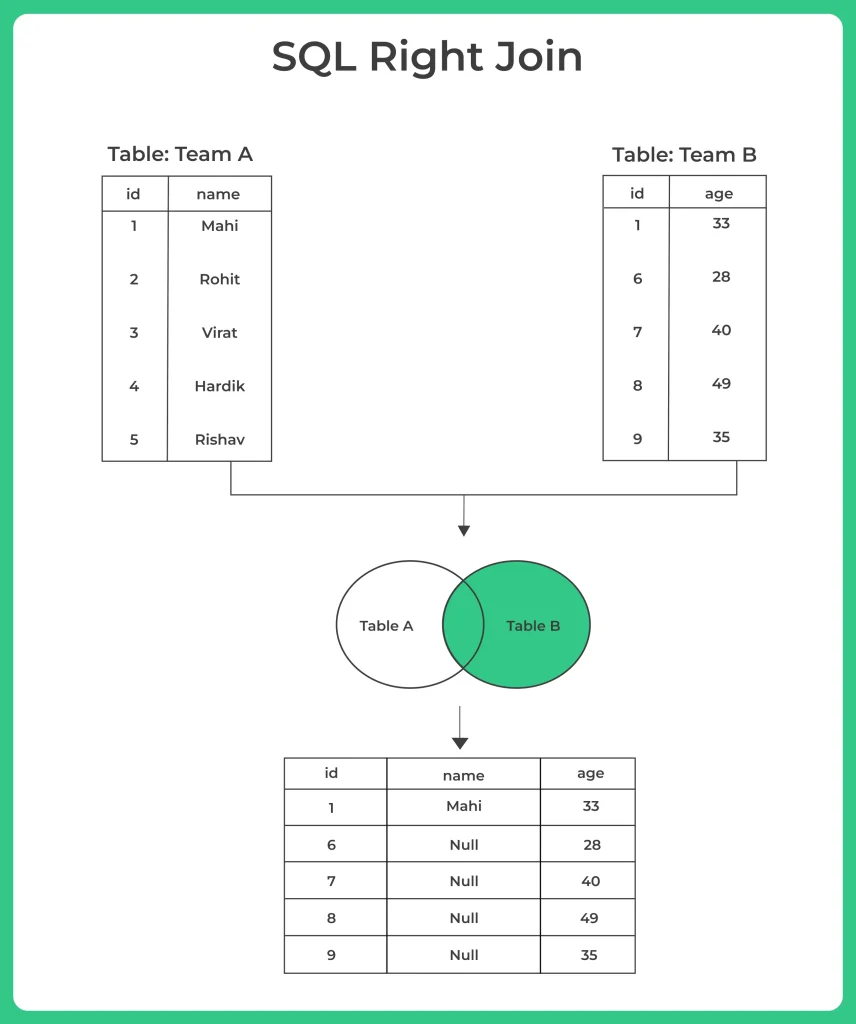SQL Right Join

Introduction to SQL Right Join
SQL (Structured Query Language) stands as the cornerstone. SQL allows us to interact with relational databases efficiently, and one of its most potent features is the “RIGHT JOIN.”
In this article, we will explore the various aspects of the SQL Right Join, its syntax, equipping you with the knowledge and skills needed to harness the full potential of your database queries.
Understanding SQL Right Join: A Complete Guide
A SQL Right Join, also known as a Right Outer Join, is a type of SQL JOIN operation that retrieves all records from the right table (table2) and only the matched records from the left table (table1). In cases where there is no match found in the left table, NULL values are assigned.
SQL Join vs. SQL Right Join: What’s the Difference? :
SELECT customers.name, orders.order_id FROM customers JOIN orders ON customers.customer_id = orders.customer_id;
SELECT employees.name, departments.department_name FROM employees RIGHT JOIN departments ON employees.department_id = departments.department_id;
Mastering SQL Right Join Syntax
- SELECT: Specifies the columns you want to retrieve in the result.
- FROM: Specifies the left table (the table from which you want all rows).
- RIGHT JOIN: Specifies the type of join operation. In this case, it’s a RIGHT JOIN.
- ON: Specifies the condition on which the tables are joined. It specifies the columns that should be compared to establish the relationship between the tables.
SELECT column1, column2, ... FROM table1 RIGHT JOIN table2 ON table1.column_name = table2.column_name;

Real-World SQL Right Join Examples
To illustrate the power of RIGHT JOIN, let’s consider a real-world scenario. Suppose you are managing a retail business, and you have two tables: one containing information about your products and another with sales data.
- You want to generate a report that includes all product details alongside the sales figures.
SELECT * FROM products RIGHT JOIN sales ON products.product_id = sales.product_id;
SQL Right Join Examples
Example 1: Joining Employee and Department Tables
SELECT Employees.EmployeeName, Departments.DepartmentName FROM Employees RIGHT JOIN Departments ON Employees.DepartmentID = Departments.DepartmentID;
Example 2: Handling Missing Data
SELECT Sales.SaleID, Salespeople.SalespersonName FROM Sales RIGHT JOIN Salespeople ON Sales.SalespersonID = Salespeople.SalespersonID;
Click below to access free SQL quizzes which will be helpful in your placement exams
SQL Right Join vs Left Join
| Aspect | SQL RIGHT JOIN | SQL LEFT JOIN | |
|---|---|---|---|
| Basic Function | Returns all rows from the right table and matching rows from the left table. | Returns all rows from the left table and matching rows from the right table. | |
| Syntax | SELECT * FROM right_table RIGHT JOIN left_table ON right_table.column = left_table.column | SELECT * FROM left_table LEFT JOIN right_table ON left_table.column = right_table.column | |
| Result Set | Contains all rows from the right table and only the matching rows from the left table. | Contains all rows from the left table and only the matching rows from the right table. | |
| Query Optimization | May not always be as optimized as LEFT JOIN, as it depends on the database optimizer’s implementation. | Generally considered more efficient, and the optimizer may be able to optimize it better. | |
| Use Cases | Useful when you want to include all records from the right table, and only matching records from the left table. |
|
Advantages of Using RIGHT JOIN :
Conclusion
SQL Right Join is a powerful tool that unlocks the potential of relational databases, allowing businesses to extract valuable insights from their data. By mastering Right Join and adhering to best practices, organizations can make informed decisions, drive efficiency, and stay competitive in today’s data-driven world.
Prime Course Trailer
Related Banners
Get PrepInsta Prime & get Access to all 200+ courses offered by PrepInsta in One Subscription

Question 1.
What is the key difference between SQL Right Join and SQL Left Join?
SQL Right Join returns all rows from the right table and matching rows from the left table, while SQL Left Join returns all rows from the left table and matching rows from the right table.

Question 2.
When should I use a SQL Right Join?
Use SQL Right Join when you need all records from the second table and want to include unmatched records from the first table.

Question 3.
How do I handle NULL values when using SQL Right Join?
You should handle NULL values appropriately in your SQL queries, depending on your analysis requirements.

Question 4.
Can I use SQL Right Join with more than two tables?
Yes, you can perform SQL Right Joins with multiple tables by chaining them together using the appropriate join conditions.
Get over 200+ course One Subscription
Courses like AI/ML, Cloud Computing, Ethical Hacking, C, C++, Java, Python, DSA (All Languages), Competitive Coding (All Languages), TCS, Infosys, Wipro, Amazon, DBMS, SQL and others




